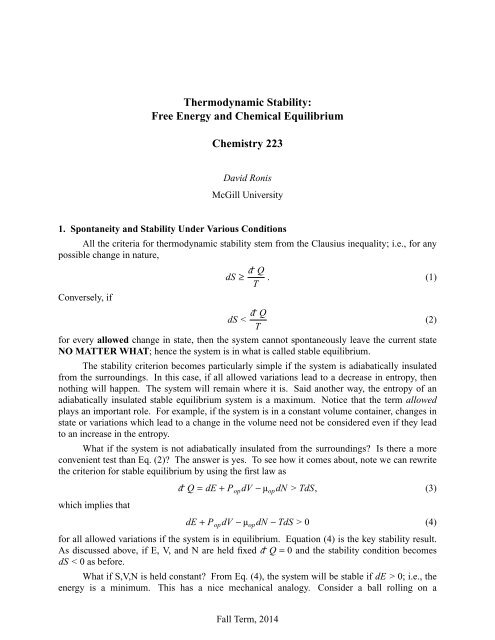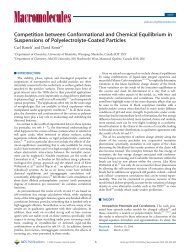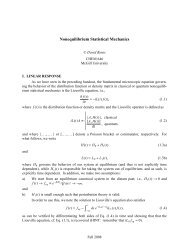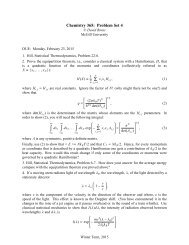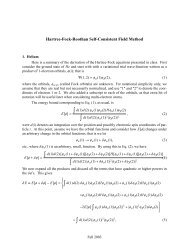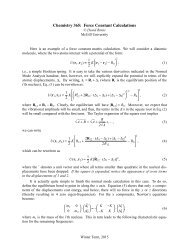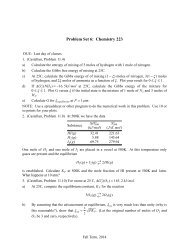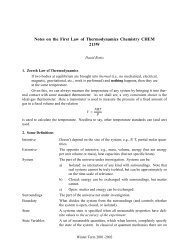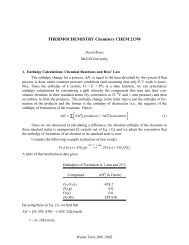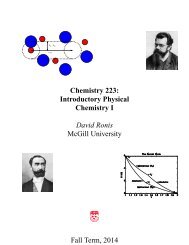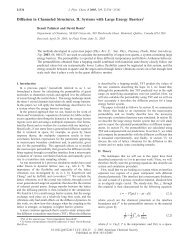Thermodynamic Stability: Free Energy and ... - McGill University
Thermodynamic Stability: Free Energy and ... - McGill University
Thermodynamic Stability: Free Energy and ... - McGill University
You also want an ePaper? Increase the reach of your titles
YUMPU automatically turns print PDFs into web optimized ePapers that Google loves.
<strong>Thermodynamic</strong> <strong>Stability</strong>:<strong>Free</strong> <strong>Energy</strong> <strong>and</strong> Chemical EquilibriumChemistry 223David Ronis<strong>McGill</strong> <strong>University</strong>1. Spontaneity <strong>and</strong> <strong>Stability</strong> Under Various ConditionsAll the criteria for thermodynamic stability stem from the Clausius inequality; i.e., for anypossible change in nature,Conversely, ifdS ≥ d− QT . (1)dS < d− Q(2)Tfor every allowed change in state, then the system cannot spontaneously leave the current stateNO MATTER WHAT; hence the system is in what is called stable equilibrium.The stability criterion becomes particularly simple if the system is adiabatically insulatedfrom the surroundings. In this case, if all allowed variations lead to a decrease in entropy, thennothing will happen. The system will remain where it is. Said another way, the entropy ofanadiabatically insulated stable equilibrium system is a maximum. Notice that the term allowedplays an important role. For example, if the system is in a constant volume container, changes instate or variations which lead to a change in the volume need not be considered even ifthey leadto an increase in the entropy.What if the system is not adiabatically insulated from the surroundings? Is there a moreconvenient test than Eq. (2)? The answer is yes. To see how itcomes about, note we can rewritethe criterion for stable equilibrium by using the first law aswhich implies thatd − Q = dE + P op dV − µ op dN > TdS, (3)dE + P op dV − µ op dN − TdS >0 (4)for all allowed variations if the system is in equilibrium. Equation (4) is the key stability result.As discussed above, ifE,V,<strong>and</strong> N are held fixed d − Q = 0<strong>and</strong> the stability condition becomesdS 0;i.e., theenergy is a minimum. This has a nice mechanical analogy. Consider a ball rolling on aFall Term, 2014
<strong>Free</strong> <strong>Energy</strong> -2- Chemistry 223frictionless parabolic surface in a gravitational field. Clearly, ifweplace the ball at rest at thelowest point then it will stay there forever. This is the point which minimizes the energy.Of course, it is not always easy to see how tohold the entropy constant in real experiments.(When is the entropy constant?) A more common situation is when the temperature ofthe system is held fixed. What is the stability criterion? The problem <strong>and</strong> its solution are similarto those which led to the introduction of the enthalpy. If(N,T,V) are held fixed, Eq. (4) becomesor since T is constant,(dE) N,T ,V − T (dS) N,T ,V >0,d(E − TS) N,T ,V >0.Thus, we see that a new state function, A ≡ E − TS, isaminimum for a stable equilibrium where(N,T,V) are not allowed to vary. This new state function, is defined via a Legendre transformationon the energy <strong>and</strong> is called the Helmholtz free energy.etc.)From the definition of A, for a general change in state (i.e., not necessarily with dT = 0,dA = dE − SdT − TdS= (d − Q − TdS) + d − W − SdT + µ op dN. (6)The Clausius inequality implies that the quantity in the parenthesis is negative (or zero for areversible process) for any spontaneous change in the state of the system. Moreover, if weconsidersystems where T <strong>and</strong> N are held fixedordA ≤ d − W(5a)(5b)−W ≤−∆A. (7)This means the −∆A is the maximum work you can get out of a process run under constant T <strong>and</strong>Nconditions (hence the name "free energy"). In addition, since A is a state function, you can getthe bound without knowing anything about the path (or device)--just by knowing the initial <strong>and</strong>final states <strong>and</strong> how tocarry out a calculation similar to those we did in thermochemistry.case,Since A is a state function, we can always compute changes along reversible paths. In thisIn addition, we pick up some new Maxwell relations, e.g.,dA =−SdT − PdV + µdN. (8)⎛ ∂S ⎞= ⎛ ∂P ⎞= α ⎝ ∂V ⎠ T ,N⎝ ∂T ⎠ V ,Nκ , (9)where α = V −1 (∂V /∂T ) P,N is the thermal expansion coefficient <strong>and</strong> κ =−V −1 (∂V /∂P) T ,N is theisothermal compressibility; the last equality follows by using the cyclic rule,Clearly, there are many different choices of which state variables can be held constant. Wewill only consider two more. First suppose (S,P,N) is held fixed. This is analogous to what weencountered with the enthalpy. Inthis case, Eq. (4) becomesFall Term, 2014
<strong>Free</strong> <strong>Energy</strong> -3- Chemistry 223for stable equilibrium; i.e., the enthalpy isaminimum.d(E + PV ) S,P,N = (dH) S,P,N >0 (10)Finally, <strong>and</strong> perhaps most importantly, suppose T, P,<strong>and</strong> N are held fixed. This is the mostcommonly encountered case. Now Eq. (4) becomesd(E + PV − TS) T ,P,N >0. (11)Thus a new state function, G ≡ E + PV − TS = H − TS, isaminimum for a stable equilibriumwith fixed temperature, pressure, <strong>and</strong> mass. This state function is called the Gibbs free energy.As was the case with the Helmholtz free energy, ∆G has a direct physical interpretation.From its definition, for a constant (T,P,N) processes,dG = dE − TdS + PdV(12a)= (d − Q − TdS) + (d − W + PdV ) ≤ (d − W + PdV ), (12b)where the last inequality follows from the Clausius inequality. For finite changes in state, wethus find that−W −∫PdV ≤−∆G. (13)What does this mean? Up to now, we have mainly considered PV work. Of course, there areother kinds (magnetic, electrical but to name two). Hence, −∆G provides an upper bound to thenon-PV work done by the system on the surroundings (i.e., −W −∫PdV )that can be obtainedfrom a constant T,P,N process. If you are manufacturing electric batteries you probably don’tcare about the amount of PV work which is wasted if the battery exp<strong>and</strong>s or contracts--all youwant is the electrical work.As in the case of the Helmholtz free energy, wecan consider arbitrary changes in theGibbs free energy along reversible paths. From its definitiondG =−SdT + VdP +As before, this gives additional Maxwell relations, for exampleΣ µ i dN i . (14)i⎛ ∂S ⎞=− ⎛ ∂V ⎞=−Vα , (15)⎝ ∂P ⎠ T ,N⎝ ∂T ⎠ P,Nwhich we obtained in a very complicated way in an earlier section.As an illustration of the usefulness of Maxwell relations, reconsider our discussion of theJoule-Thompson coefficient:µ JT =− 1 ⎛ ∂H ⎞=− 1 ⎡C P ⎝ ∂P ⎠ ⎢⎣ T ⎛ ∂S ⎞+ V ⎤T ,NC P ⎝ ∂P ⎠⎥ =− V (1 − Tα ),T ,N ⎦C Pwhere the last equality follows by using Eq. (15) <strong>and</strong> the one before that by noting thatdH = TdS + VdP + µdN. Note that the notation often gives aclue where to look for a Maxwellrelation. In our example, the entropy derivative is with respect to P, keeping T <strong>and</strong> N constant.The state function whose natural or canonical variables are T, P,<strong>and</strong> N is G, <strong>and</strong> this is where wegot the Maxwell relation just used.Fall Term, 2014
<strong>Free</strong> <strong>Energy</strong> -4- Chemistry 223One final point, note that the partial molar Gibbs free energy isG i = ⎛ ∂G ⎞= µ⎝ ∂N i ⎠ i , (16)T ,P,N j≠iwhere Eq. (14) was used. Hence, in a one component system, the Gibbs free energy per mole isjust the chemical potential. More generally, G i ,the partial molar quantity for the i’th componentis µ i ,<strong>and</strong> hence, from Euler’s theoremG =Σ N i µ i . (17)iAs we discussed earlier, inorder that Eqs. (17) <strong>and</strong> (14) be consistent, a Gibbs-Duhem relationmust hold; i.e.,0 = SdT − VdP +Σ N i dµ i , (18)iwhich shows that the changes in temperature, pressure <strong>and</strong> chemical potentials are not all independent.The various stability results are summarized in the following table.Criteria for Stable EquilibriumState Stable Equilibrium SimplestHeld Fixed Definition DifferentialFunction Criterion Physical ContentAdiabatic *(e.g., E,V,N)S∆S =∫ dQ revTdS = dQ revTmaximum -S,V,N E ∆E = Q + W dE = TdS − PdV + Σ µ i dN i minimum ∆E V ,N = Q V ,NS,P,N H H ≡ E + PV dH = TdS + VdP + Σ µ i dN i minimum ∆H P,N = Q P,NT,V,N A A ≡ E − TS dA =−SdT − PdV + Σ µ i dN i minimum −W T ,N ≤−∆A T ,NT,P,N G G ≡ H − TS dG =−SdT + VdP + Σ µ i dN i minimum −W non−PV ≤−∆G P,N* E,N,V implies adiabatic in systems where only PV or chemical work is allowed, the reverse is not true if other kinds orwork (e.g., electrical) are possible.iiii2. Examples of free energy calculations<strong>Free</strong> energy calculations are carried out in much the same as enthalpy calculations. Thereare tables of st<strong>and</strong>ard free energies of formation of compounds. Elements in their st<strong>and</strong>ardstates are assigned zero astheir Gibbs free energy of formation.Consider the following chemical reaction:Fall Term, 2014
<strong>Free</strong> <strong>Energy</strong> -6- Chemistry 2232.1. Coupled ReactionsIn some cases, the direct formation of a certain compound by direct reaction is thermodynamicallyforbidden. An example is the formation of titanium tetrachloride 1from common TiO 2 ore; i.e.,TiO 2 (s) + 2Cl 2 (g) → TiCl 4 (l) + O 2 (g).It turns out that ∆G =+152. 3kJ/mole. Nonetheless, we can make the reaction go by coupling itto one which pulls it along. For example, suppose we use the produced oxygen to burn carbon;i.e.,C(s, graphite) + O 2 (g) → CO 2 (g),where here ∆G =−394. 36kJ/mole. The free energy change for the coupled processes is -394.36+152.3 = -242.1 kJ/mole, <strong>and</strong> thus the coupled reaction can proceed. The burning carbon suppliesthe needed free energy to make the desired reaction work.2.2. General Tr endsFor this discussion, we will consider systems were the reactions take place at a fixed temperature<strong>and</strong> pressure; as such, the direction of change is determined by∆G =∆H − T ∆S,where ∆H <strong>and</strong> ∆S are the enthalpy <strong>and</strong> entropy change for the process, at the actual temperature<strong>and</strong> pressure. As we have said, for constant pressure <strong>and</strong> temperature processes, ∆G
<strong>Free</strong> <strong>Energy</strong> -7- Chemistry 2233.1. <strong>Thermodynamic</strong>s of Chemically Reacting SystemsAvery important example of thermodynamic equilibrium is that of chemical equilibriumat constant pressure <strong>and</strong> temperature. Consider the following general chemical reaction:2A + B → ← 3C + D.The chemical equation imposes a strong constraint on the changes in the numbers of moles ofeach component; for the forward reaction, each time a mole of B reacts, 2 of A are used up <strong>and</strong> 3of C <strong>and</strong> one of D are produced. Mathematically,dN A−2= dN B−1= dN C3= dN D1≡ dξ , (21)where the extent of the reaction is characterized by the quantity ξ (the Greek letter, pronouncedkse) called the progress variable. For an arbitrary chemical reaction involving r chemical components,the last expression generalizes todN 1ν 1= ... = dN rν r≡ dξ , (22)where ν i is the stoichiometric coefficient for the i’th component in the reaction (by convention, itis negative for reactants). This is just a mathematical formulation of the law ofdefinite proportionsdue to Joseph Proust, 1806, who wrote:"I shall conclude by deducing from these experiments the principle I have establishedat the commencement of this memoir, viz. that iron like many other metals issubject to the law ofnature which presides at every true combination, that is to say,that it unites with two constant proportions of oxygen. In this respect it does not differfrom tin, mercury, <strong>and</strong> lead, <strong>and</strong>, in a word, almost every known combustible."One can easily relate the actual amounts of compounds present at any stage of the reactionimply by integrating Eq. (22); i.e., N i = N (0)i + ν i ξ ,where N (0)i is the amount of compound ipresent when ξ = 0, i.e., at the start of the reaction.For constant temperature <strong>and</strong> pressure <strong>and</strong> total mass (for each element) conditions, thereaction can proceed until the Gibbs free energy is a minimum with respect to all allowed variationsin the state of the system. By knowing the amounts of the various compounds in terms of ξit is easy to express the Gibbs free energy in terms of ξ using Euler’s theorem (cf. Eq. (17)):where µ i is usually a function of ξ as well.⎛ ∂G ⎞G(ξ ) = Σ N i =i ⎝ ∂N i ⎠Σ(N (0)i + ν i ξ )µ i ,T ,P,N j≠iiFor fixed total mass, temperature, <strong>and</strong> pressure, the only variations which can be consideredare those which change ξ . Hence, we could use the last equation to plot G(ξ )versus ξ ;i.e.,the reaction moves either to the right or left until G(ξ )isaminimum. Instead of determining theequilibrium point graphically, wecan use calculus. We know that G can be a minimum withrespect to changes in the progress variable only if⎛ ∂G ⎞= 0 (23)⎝ ∂ξ ⎠ T ,P,NtotalFall Term, 2014
<strong>Free</strong> <strong>Energy</strong> -8- Chemistry 223<strong>and</strong>⎛ ∂ 2 G ⎞>0. (24)⎝ ∂ξ 2 ⎠ T ,P,NtotalBy using the differential form for the change in the free energy together with Eq. (22) we findthatwhich when used in Eq. (23) givesdG =−SdT + VdP + Σ rν i µ i dξ , (25)∆G ≡ ⎛ ∂G ⎞⎝ ∂ξ⎠ T ,P,Ntotali=1= rΣ ν i µ i = 0 (26)at equilibrium. ∆G is called the reaction Gibbs free energy. Since the µ i are the partial molarGibbs free energies, Eq. (26) is equivalent to ∆G = 0. At equilibrium the free energy changein the reaction per mole vanishes. (Indeed, this is the principle we applied in the "reaction"between graphite <strong>and</strong> diamond). From the definition of the Gibbs free energy (G = H -TS), it followsthati=1at equilibrium.∆S = ∆H TWhat happens if we change temperature or pressure by a small amount? Which way willthe equilibrium shift? To answer this, first note the following Maxwell relations:⎛ ∂µ i ⎞⎝ ∂T⎠ P,N j=− ⎛ ∂S ⎞=−S⎝ ∂N i ⎠ i (27a)P,T ,N j≠i<strong>and</strong>⎛ ∂µ i ⎞⎝ ∂P⎠ T ,N j= ⎛ ∂V ⎞= V⎝ ∂N i ⎠ i (27b)P,T ,N j≠iwhich follow from the Gibbs free energy. Thus the changes in the chemical potential associatedwith temperature or pressure are related to the partial molar entropies or volumes, respectively.Next consider⎛ ∂µd( Σν i µ i ) =i ⎞⎛ ∂µΣν i dT +i ⎞Σν⎝ ∂T ⎠ i dP + ⎛ ∂(Σν i µ i ) ⎞dξP,N j⎝ ∂P ⎠ T ,N j⎝ ∂ξ ⎠ T ,P,Ntotaliii=−∆SdT +∆VdP + ⎛ ∂∆G ⎞dξ , (28)⎝ ∂ξ ⎠ T ,P,Ntotalwhere, cf. Eqs. (27), ∆S ≡ Σν i S i <strong>and</strong> ∆V ≡ Σν i V i are the entropy <strong>and</strong> volume changes per moleof reaction. Equation (28) shows how the free energy change per mole of reaction changes whenwe change T, P,or ξ .What happens if we change, T or P in a system where chemical reaction is possible? Theprogress variable will change until Eq. (26) is again valid. Since both the initial <strong>and</strong> final statesFall Term, 2014
<strong>Free</strong> <strong>Energy</strong> -11- Chemistry 223One final point. In the preceding examples, we’ve assumed that all the compounds are gases, <strong>and</strong>hence, have used Eq. (31b) for the chemical potentials. Should one or more of the componentsbe in a condensed (strictly speaking, pure) phase, e.g., solid or liquid, then we would have to useEq. (31a) instead. Moreover, since the molar volumes of liquids <strong>and</strong> gases are small, we canignore the pressure term in Eq. (31a) as long as the P − P o isn’t too large. For our discussion ofequilibrium constants, this has one consequence; namely, the condensed phase components dropout of stoichiometric quotient. Note that this is not true for solutions.5. Examples of Chemical Equilibrium Calculations5.1. Determination of <strong>Free</strong> Energies of FormationThere are a number of ways in which to measure the st<strong>and</strong>ard free energies of formation ofacompound. Consider the formation of ammonia,12 N 2(g) + 3 2 H 2(g) → ← NH 3(g),at STP. The free energy change for the reaction is ∆G (0)f (NH 3 , g). If we measure the equilibriumconstant,P NH3P 1/2N 2P 3/2H 2then we can easily compute the free energy of formation of ammonia.5.2. Determination of the Extent of a ReactionReconsider the reaction= e −∆G(0) f (NH 3 ,g)/RT , (37)N 2 O 4 (g) → ← 2NO 2(g).The extent of the reaction is easily measured by measuring the apparent deviation from the idealgas law. Asbefore, let α be the fraction of N 2 O 4 dissociated. If there were N 0 moles of N 2 O 4initially, then there are (1 − α )N 0 <strong>and</strong> 2α N 0 moles of N 2 O 4 <strong>and</strong> NO 2 at equilibrium, respectively.The corresponding partial pressures can be computed from Dalton’s law.When the result is used in the equilibrium constant condition we find thatK P = P2 NO 2= 4α 2 N 0 RTP N2 O 41 − α V= 4α 2 P1 − α 2 , (38)where P is the total pressure on the system. This can be solved for the fraction dissociated, withthe result thatK Pα = ⎛ ⎞⎝ K P + 4P ⎠Thus, if we calculate the equilibrium constant from a table of free energies, the degree of dissociationis easily found. Note that the result depends on both T <strong>and</strong> P. From tables of st<strong>and</strong>ardenthalpies of formation (Castellan), ∆H (o) = 2 × 33. 18 − 83. 7 =−17. 3 kJ/mol 0, assuming ideal gases. Hence, according to LeChatellier’s1/2Fall Term, 2014
<strong>Free</strong> <strong>Energy</strong> -12- Chemistry 223principle we expect that the reaction should shift to the left (i.e., less dissociation) as pressure isincreased. Our final equation for α shows this. For this reaction, as we shall see in the next section,K P (T )decreases as temperature increases, which when used with our expression for α isagain consistent with LeChatellier’s principle.5.3. Temperature Dependence of K PThe equilibrium constant, K P ,isonly a function of the temperature. From its definition,cf. Eq. (34),d ln(K P )dT=− d(∆G(0) /RT )dT=− 1 ⎛RT 2 ⎜T d(∆G(0) )−∆G (0)⎞ ⎟ = T ∆S(0) +∆G (0)=⎝dT ⎠RT 2∆H(0)RT 2 ,(39)where the second to last equality follows when Eqs. (27a) <strong>and</strong> (34) are used. This is known asthe Gibbs-Helmholtz equation. Thus, by integrating we find thatln ⎡ K P (T 2 ) ⎤⎢ ⎥ =⎣K P (T 1 ) ∫ T 2⎦(0)∆H ⎛ 1dT ≈ − 1 ⎞RT2R ⎝ T 1 T 2 ⎠ . (40)T 1∆H (0)Equation (40) follows if we assume that ∆H (0) is approximately constant with respect to temperature,or equivalently, that ∆C P ≈ 0(which also implies that ∆S (0) is constant. Why?). Indeed,with this approximation, Eq. (40) simply states thatK P (T 2 ) ⎛K P (T 1 ) = exp ⎜− ∆G(0) (T 2 )+ ∆G(0) (T 1 ) ⎞⎟, (41)⎝RT 2 RT 1 ⎠where ∆G (0) (T ) =∆H (0) − T ∆S o ,asusual. Finally, note, that as in our discussion of LeChatellier’sprinciple, the equilibrium will shift to the product side, i.e., K P increases, when the temperatureis raised if ∆H (0) >0.There is a simple graphical way in which to apply the Gibbs-Helmholtz equation. Byexpressing Eq. (39) as a differential, it follows thatd ln(K P ) =∆H(0)(0)dT =−∆HRT2Rd⎛ 1 ⎞⎝ T ⎠ ;hence, plotting ln(K P )versus 1/T will give a curve whose slope at any point is −∆H (0) /R, <strong>and</strong> tothe extent that ∆H (0) is independent of temperature, will give a straight line. This is a powerfulway todetermine enthalpy (<strong>and</strong> entropy) changes without having to do calorimetry.5.4. <strong>Free</strong> <strong>Energy</strong> <strong>and</strong> Entropy of MixingPerhaps the simplest process is one where two samples of different pure gases are isothermallymixed as depicted in the figure belowFall Term, 2014
<strong>Free</strong> <strong>Energy</strong> -13- Chemistry 223A(P,T,V) +B(P,T,V)A+B (P,T,2V)As you might expect, this process always occurs spontaneously. The total pressure ‡ <strong>and</strong> temperatureremain constant during the process (at least for an ideal gas). What is the Gibbs free energychange?From Eq. (32), it follows that the free energy of the final state isG final = N 1⎡⎣µ (0)1 (T ) + RT ln(P 1) ⎤ ⎦ + N 2 ⎡ ⎣ µ(0) 2 (T ) + RT ln(P 2) ⎤ ⎦ . (42)Similarly, the Gibbs free energy of either of the pure samples isG i = N ⎡ i µ (0)⎣i (T ) + RT ln(P) ⎤ ⎦(43)<strong>and</strong> hence, the free energy of mixing per mole of mixture, ∆G mix ,is∆G mix = RTx 1 ln(x 1 ) + RTx 2 ln(x 2 ), (44)where x i is the mole fraction of i <strong>and</strong> where Dalton’s law of partial pressures, P i = Px i ,wasused. It is easy to generalize this result to arbitrary mixtures of ideal gases∆G mix = RTΣ x i ln(x i ). (45)iSince 0 < x i 0. (47)i∆H mix =∆G mix + T ∆S mix, (48)it follows that the heat of mixing associated with the mixing of ideal gases is zero. No heat isabsorbed or released for the mixing of ideal gases. The process is driven entirely by entropy.As we shall see next term, a similar result holds for the mixing of dilute solutions. Similarly,‡ For this to happen, it is necessary that the pressures in the unmixed state be identical; hence,PRT ≡ N A≡ N B= N A + N BV A + V B,V A V Bwhere the first two equalities are conditions on the initial state, while the last one follows from the precedingtwo.Fall Term, 2014
<strong>Free</strong> <strong>Energy</strong> -14- Chemistry 223note that there is no volume change for mixing ideal gases (see Eq. (14) <strong>and</strong> take apressure derivative).In abinary mixture, what composition has the most negative free energy of mixing?Fall Term, 2014


